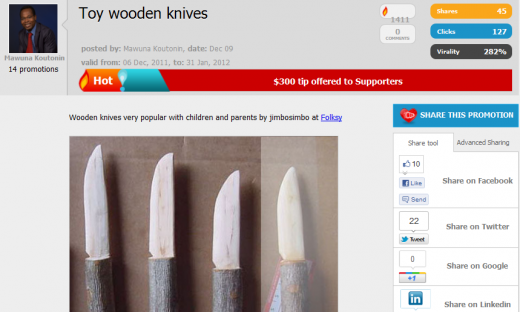
We first covered GoodBuzz back in April 2011, at a time when it was a niche networking website for professionals. It was a Web-based peer referral network to help users promote events through grassroots marketing and now, well, it’s turned on its heels and relaunched as a slightly different proposition.
“From last September, we went on to completely redesign the application,” says founder and CEO Mawuna Koutonin. “Goodbuzz is now an open network, and the basic concept is crowdsourcing advertising budgets.”
The London-based startup has launched a social marketing app that seeks to challenge advertisers not to spend their funds in the traditional way, but instead give their marketing budget directly to their fans, followers and clients to do the promotion work for them.
It certainly sounds a bit bonkers on the surface, but Mawuna explains: “Imagine you have a $1,000 budget to promote your website, your shop on Etsy, or a new product,” says Mawuna. “How will you spend this money? Will you spend it to buy clicks on Google Adwords? Buy traffic from Stumbleupon? Clicks from Reddit? How about Facebook Ads, or a banner display on some blogs or affiliate networks?
“Whatever your decision, now ask yourself, when you’re looking for an event to go to, a product to buy, or a non-profit to support, do you pay attention to advertising or do you listen to what your friends recommend?” continues Mawuna. “If your answer is, ‘I listen more to my friends and direct contacts’, then GoodBuzz is the crowd advertising tool you need to promote your next product launch or business events.”

So how exactly does this work? Well, advertisers post their advertisement to the GoodBuzz website and then deposit a tip (a sum of money) for people who like the advertisement and want to spread the message to friends and followers. At the end of the campaign, the tip is split between these sharers, relative to the leads they’ve generated.
The process of getting started with GoodBuzz runs roughly like this:
- Create an account
- Click on the Start a promotion button and upload the content you want to promote
- Deposit a tip, as you would in a restaurant or bar, for those who will share your advertisement with their friends and contacts.
- Your advertisement will be displayed on GoodBuzz, like this one:

- People will visit your advertisement page on GoodBuzz and start sharing it with their friends and contacts.
- You can check in real-time how many people are sharing your promotion on the Statistics page
- At the end of the campaign (maximum 1-month), the tip you left is distributed to all the people who spread your message, relative to the number of leads they have generated. The Goodbuzz software tracks and calculates everything automatically.
Tracking and tipping
The advertiser decides how much the tip will be, but the minimum is $50. GoodBuzz takes 10% in total from the amount earned by supporters when they decide to cash out.
So how exactly does the platform track who shares what and with how many people? And how is the tip divided? “The platform generates a unique tracking code for each user and promotion, and we use a combination of cookies, browsers and network information to track in real-time promotion results,” says Mawuna. “Users don’t receive a tip simply by sharing a promotion. And the amount of tip they receive doesn’t depend on the number of friends or followers they have. It depends on engagement and influence: how many of their friends and followers were interested in the promotion, then visited or clicked on the promotion.”
The tip is then shared depending on the number of leads the user has generated for the promotion. “We use a metric called “Tip per lead,” adds Mawuna.
Now, a lead is a combination of two things: a unique view of the campaign and a unique click on any link inside the promotion content. More specifically, 1 lead = 1 view + 1 click. However, a view represents only 20% of the lead and a click represent 80% of the value of the lead.
Each person who helped the advertiser is called a supporter. Each supporter receives a part of the tip depending on how many leads he or she has generated. At the end of the campaign, 90% of the tip is shared between all supporters depending on the number of leads they generated and 10% of the tip is shared equally as a bonus package by the top 10 supporters.
To me, it seems that this sort of initiative would lend itself much better if it was to integrate within existing e-commerce sites. So, for example, there might be a GoodBuzz button embedded on a third-party site which users click and are then given the option of sharing across their social networks. As it stands, I suspect people would visit GoodBuzz purely with dollar signs in their eyes, rather than harboring any intention of sharing their genuine likes. Indeed, this is something Mawuna acknowledges, noting: “We have something in the pipeline that should be released soon.”
As for the pivot, Mawuna explains. “Slowly, it dawned on us that the best idea was to use the most widespread social incentive system – tipping – to leverage the most widespread social behavior on the Web – sharing,” he says. “This will help our members succeed with their promotion.”
Spam, spam, spam
I also asked Mawuna about the potential for spam. There’s a danger that people will visit GoodBuzz and share things across the social sphere purely because it will get them money: people spamming their friends and followers for the sake of money.
“Spamming could be a problem, but we control spam at 3 levels,” explains Mawuna. “The tip a sharer receives depends on how their friends like the content they shared. If their friends don’t like what has been shared, they won’t receive a tip and they will be discouraged or become more aware about the kind of content to share. Tips aren’t given purely for sharing a promotion, it depends on the leads generated for the advertisers.”
Mawuna also reckons education will be key, letting sharers know what kind of content they might share and what are the best ways to find and share valuable content with their friends. “We also educate our advertisers and brands about what kind of content people share on social media and how they should frame their promotions to align themselves with the best practices,” adds Mawuna.
From previous versions of the platform, Mawuna says that a typical sharer on GoodBuzz could earn up to $120 a month. As GoodBuzz has just launched, there are only a few promotions available just now as the platform prepares to exit beta.
Meanwhile, you can watch the official GoodBuzz promo video below.
➤ GoodBuzz
Get the TNW newsletter
Get the most important tech news in your inbox each week.





